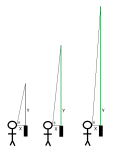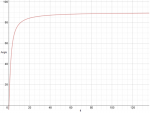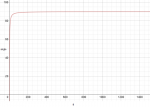^that's pretty much what I illustrated.
which causes enhanced scattering of the laser beam back to your eyes. Above the PBL, which can be very low at night (<100 m), the amount of aerosols is very low compared to within the PBL, and as a result the scattering of the laser beam appears to end abruptly
Again I'll say: That would mean pointing at the horizon would make the beam much longer. That is not the case.
I'll try to draw something better...
We do not see in length, we see in angles. That is why objects farther away look smaller - they take up less angle:
So lets just measure a laser beam as the angle of vision that it occupies (since that's what the op is asking about anyways) instead of the "actual length."
Say you were holding the pointer 2 feet away from you with an outstretched arm at eye level pointing directly upwards. A few hypotheticals (and a preview to calculus :shhh: ) - Let's assume zero divergence, and infinite atmosphere with no variation throughout. What if the laser actually stopped at 10 feet? What about 20? 30? What angle of our vision would be occupied?
If you'll recall from your trig class (and for those of you that haven't had trig, you'll just have to trust me

), the
tangent of the angle θ is the length of the opposite side of the triangle divided by the length of the adjacent side of the triangle. In this case:
tanθ=Y/X
Taking the inverse tangent: θ=arctan(Y/X)
Since X is hypothetically 2: θ=arctan(Y/2)
We find the answers for 10, 20, and 30ft to be 78.7°, 84.3°, and 86.2°
What about for 100 feet, 200 feet, or 300 feet? Those would be 88.9° 89.4°, and 89.6°
Do you see a pattern? This is where graphing comes in handy.
It seems to be approaching the number 90, no matter how long the laser gets. Let's zoom out further...
Which begs the question, could you even tell the difference between a 300ft beam and a 300-trillion foot beam? Not if it originates in your hand you couldn't. Not unless you had something to terminate the beam on for reference. That's the angular difference between 89.6° and 90°.









